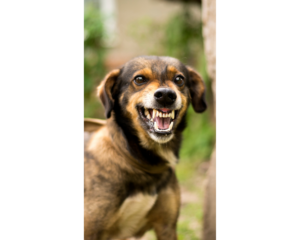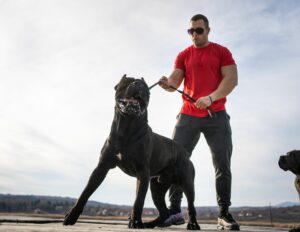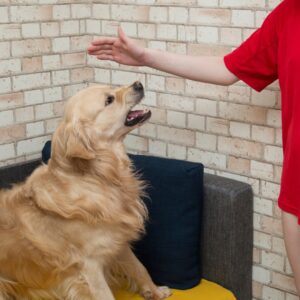Are there Options for Dogs with Aggression?

Having a dog that exhibits aggressive behavior is stressful. Dogs can begin to show aggressive behaviors early on or evolve into aggressive behavior over the years. Sometimes dog owners don’t realize their dogs are having difficulties or are unaware of behavioral issues. In other cases owners see these behaviors as something that will eventually pass. But oftentimes dog owners are aware they have a serious problem.
Explaining Aggressive Behaviors
Aggression is an array of activities, which range from minor postures to dangerous attacks. Aggressiveness is generally exhibited when dogs are scared or angry. Aggressive behavior in dogs can range from a warning, admonishing, defending or protecting, or actually causing harm. Basically, aggressive behaviors are intended to decrease distances from perceived threats to other persons, or cause harm to those perceived as a risk.
What are the warning signs of aggression?
It’s important to know what signals can be detected when aggression occurs. Aggression usually precedes a fear appeasing signal, sometimes referred to as a calming signal. These incoming signals are aimed at diffusing social conflicts.
Body language indicators of a dog escalating into aggression can include standing stiffly, intense eye contact, a lowered body posture, and raised hackles (the fur along its back and neck). Other signs include snarling, growling, snapping, or lip licking. It’s important to be aware of these signs and to try to stop the situation from escalating before it reaches a point of aggression.
Aggressive behavior can include:
Lunging, growling, barking, snapping, nipping, and biting. These types of behaviors often occur when the dog feels threatened or is trying to protect their territory. It’s important to understand how to address these types of behaviors so that you can provide a safe and healthy environment for your dog.
What are manifestations of fear or anxiety related aggression?
Fear-related aggression is most common in dogs. Most forms of aggression, including maternal and pain induced aggression, may have an element of worry or anxiety. The first manifestation is typically defensive, displaying as a need to increase distance and communication to ‘stay away’, but aggressive behavior develops as an underlying threat with time. Aggression is most dangerous when shown at an extreme distance from perceived threats.
Listen to the warning signs to avoid escalation of an aggressive response
Dogs communicate with us and other dogs all the time through their body language. Unfortunately, if you aren’t trained to see the behaviors that precede barking, lunging and biting, it can look to you like your dog just randomly acts aggressive. It’s always a good idea to consult your veterinarian when your dog is acting different or more agitated. Most aggressive outbursts don’t come out of nowhere. Lots of body language is used in dogs to tell us about how they are feeling about certain things.
Aggressive Dog Body Language
Here is an informative video on how dogs communicate made by Fear Free Happy Homes.
Lip licking, freezing, turning away, yawning, walking away or flattening of ears can be signs your dog is unhappy. These behaviors tend to come in clusters when your dog feels stressed. Not every yawn is a sign of stress and sometimes lip licking is just the anticipation of a treat. It can take a bit of time and observation to understand what your dog is saying. Once you have seen this brilliant way of communicating you will never “un-see” it.
A dog that bites you when you try to clip his nails has likely given you lots of warning signs before lashing out, but you didn’t respond to the warning that escalated to biting.
A dog that is uncomfortable with other dogs in his personal space will often turn away and freeze before snarling or snapping at the other dog. Just imagine going grocery shopping and having a random people come up and hug you without asking for permission. How many people will you endure before you’ve had enough and yell or push someone away to avoid being hugged by another stranger? This is how your dog might feel when he is in situations with unfamiliar people that he doesn’t want to be in.
You can help your dog by learning as much as you can about his body language so he doesn’t need to escalate. You can also get him out of uncomfortable situations before he feels like biting is the best way to stop whatever is happening.
There are many kinds of aggression in dogs. A few examples are fear aggression, possession aggression, redirected aggression and defensive aggression. You can minimize aggressive responses by learning your dog’s subtle signs of discomfort.
Aggressive Dog Management
 If your dog behaves aggressively in certain situations, try to avoid those situations. The more your dog practices aggression the more he will use this strategy to cope with things that make him uncomfortable.
If your dog behaves aggressively in certain situations, try to avoid those situations. The more your dog practices aggression the more he will use this strategy to cope with things that make him uncomfortable.
If your dog doesn’t like visitors in your home, give him a nice chewy and put him in a safe space. This will take the stress away for everyone. Work with a dog trainer that uses positive reinforcement and knows how to change behaviors to help you with this problem.
If your dog sometimes fights at the dog park, avoid taking him to the dog park. He may be trying to tell you that he doesn’t like having strange dogs running up to him trying to play.
If your dog lunges at other dogs on walks, avoid taking him around the neighborhood where he encounters multiple dogs on every walk. He may not be having a good time on these outings, find more remote places to walk him instead.
If your dog growls at you when you pet him or while he is eating, this is a warning that he is not comfortable and you should stop. He might not have bitten you yet, but you are not helping the situation and he might decide to escalate at some point. Also realize that putting your hand in a food bowl will not teach him to enjoy your presence while he is eating. Just imagine that you are eating, and someone walks up to you puts his hand on your plate!
How many kinds of aggression are there?
-
Territorial Aggression: Becoming aggressive when the dog feels its territory is being invaded.
-
Defensive Aggression: Becoming aggressive as a form of self-protection.
-
Fearful Aggression: Becoming aggressive out of fear.
-
Possessive Aggression: Becoming aggressive over possessions such as food or toys.
-
Social Aggression: Becoming aggressive towards other dogs or animals.
-
Redirected Aggression: Becoming aggressive at something within reach rather than a stimulus they cannot reach, such as a perceived threat outside the window.
-
Impulse Control aggression / Dominance aggression
-
Pain related aggression
-
Maternal aggression
-
Protective aggression
-
Predatory aggression
What to do with an aggressive dog?
Safety first!
Get a head start on safety by teaching your dog to wear a muzzle, using a positive approach. Read more about muzzle training here: Is your dog muzzle trained?
Use baby gates or other barriers to keep everyone safe. Use a leash when you have visitors over until your dog is comfortable with the new person in the house.
Identify and respect your dog’s triggers! Once you know what gets your dog upset you can start changing his emotional response to the trigger. Since this is easier said than done, a qualified professional can help you know how to condition your dog’s feelings about his triggers
Stop using punishment!
 Using punishment based methods to try to stop aggressive behaviors may feel like the right thing to do, but it can too often escalate your dog’s negative feelings about the thing he is reacting to. There are many strategies that are helpful in curbing aggression, so reach out if you need help.
Using punishment based methods to try to stop aggressive behaviors may feel like the right thing to do, but it can too often escalate your dog’s negative feelings about the thing he is reacting to. There are many strategies that are helpful in curbing aggression, so reach out if you need help.
Do fun stuff with your dog!
It can be exhausting and embarrassing to have a dog that growls, barks and lunges. Remember your love for your dog and make a practice of engaging in fun activities together to help both of you through this hard time. Your dog is not trying to give you a hard time, he is struggling and doesn’t have other ways to cope with the situations that bother him.
Enrichment is a big part of making your dog feel better. A happy and satisfied dog that is able to regularly engage in species-typical behavior is much less likely to lash out. A dog that has no hobbies or activities, doesn’t get to explore the world, or play with his human is more likely to show aggression.
Who can help?
Your veterinarian can help determine if mental or physical health problems could be causing aggression. If there are identifiable issues, the vet can help by developing a treatment plan that may include medications, therapies or special diets. A Veterinary Behaviorist or a Certified Applied Animal Behaviorist can also help your dog using behavior modification and other techniques (as well as medication if needed). This type of training focuses on using positive reinforcement and other methods to correct a dog’s aggression. Although it takes time, this type of training has the potential to improve your dog’s behavior long term. If appropriate, a veterinarian can also help you decide when your dog’s quality of life is too poor or the risks of living with your dog are too high and euthanasia is warranted.
Find a Certified Applied Animal Behaviorist (CAAB or ACAAB), a Veterinary Behaviorist (Dip ACVB), a Certified Dog Behavior Consultant (CDBC), or a Certified Behavior Consultant (CBCC-KA) in your area.
Certified Applied Animal Behaviorists
Find a Board Certified Veterinary Behaviorist
International Association of Animal Behavior Consultants
Certification Council for Professional Dog Trainers
Do you have a dog that bites? Canine aggression is a dangerous behavior problem. Don’t wait to reach out as quickly as possible to a professional that can help you navigate this behavior and avoid severe consequences to other dogs, animals or family members.
Do you need help with your aggressive dog? We can help!
Want to learn more about dogs that bite? When your best friend bites.


